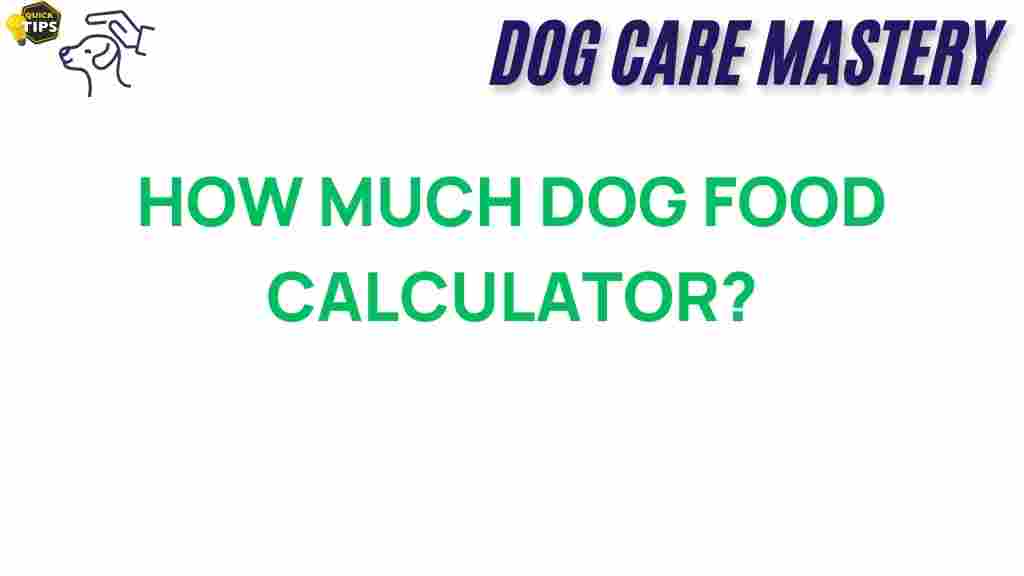Unlocking the Secrets: How Much Dog Food Calculator Can Transform Feeding
Feeding your dog appropriately is crucial for their overall health and well-being. With so many dog food options available, it can be overwhelming to determine how much food your furry friend actually needs. This is where a dog food calculator comes in handy. In this article, we will explore how a dog food calculator can transform your feeding routine, ensuring your pet gets the right nutrition every day.
What is a Dog Food Calculator?
A dog food calculator is a handy online tool designed to help pet owners determine the appropriate amount of food to feed their dogs based on various factors. These factors typically include:
- Dog’s weight
- Age
- Activity level
- Health status
- Type of food
By inputting these variables, the calculator generates a recommended daily feeding amount tailored specifically to your dog’s needs. This ensures that your pet receives the right balance of nutrients without overfeeding or underfeeding.
Why Use a Dog Food Calculator?
Using a dog food calculator can provide several advantages for both you and your dog. Here are some key benefits:
- Prevents Obesity: Overfeeding can lead to obesity, which is a common issue among pets. A calculator helps you measure the correct portion sizes.
- Tailored Nutrition: Every dog is unique. A calculator allows for adjustments based on individual health needs and lifestyle.
- Convenience: It saves time and takes the guesswork out of feeding your dog.
- Improved Health: Proper nutrition contributes to better overall health, increased energy levels, and a longer lifespan.
Step-by-Step Process to Use a Dog Food Calculator
Using a dog food calculator is simple. Follow these steps to ensure you get the most accurate results:
Step 1: Gather Necessary Information
Before using the calculator, make sure you have the following information ready:
- Weight: Weigh your dog accurately using a scale.
- Age: Knowing if your dog is a puppy, adult, or senior is crucial.
- Activity Level: Consider whether your dog is highly active, moderately active, or sedentary.
- Health Status: If your dog has any health issues, this should be factored into the calculation.
- Type of Food: Different dog foods have varied caloric densities. Make sure to know the specific brand and type you are feeding.
Step 2: Input Your Dog’s Information
Navigate to a reputable dog food calculator online. Many pet supply websites offer free tools. Enter the information you gathered in Step 1 into the calculator:
- Dog’s weight (in pounds or kilograms)
- Dog’s age (puppy, adult, or senior)
- Activity level (low, moderate, high)
- Health considerations (if applicable)
- Type of food (dry, wet, raw, etc.)
Step 3: Review the Recommendations
After inputting the information, the calculator will provide you with a recommended daily feeding amount. This will typically be given in cups or grams. Review the recommendations carefully and consider them as a starting point. Depending on your dog’s specific needs, you may need to adjust the amount slightly.
Step 4: Monitor Your Dog’s Weight
Once you start feeding according to the calculator’s recommendations, monitor your dog’s weight and overall health. If you notice weight gain or loss, you may need to revisit the calculator for adjustments. Regularly check in with your veterinarian to ensure your dog’s diet remains appropriate as they age.
Troubleshooting Common Issues
While using a dog food calculator is straightforward, you may encounter some challenges. Here are some common issues and how to address them:
Issue 1: Weight Fluctuations
If your dog is gaining or losing weight significantly after following the calculator’s recommendations, consider the following:
- Reassess Activity Level: Has your dog’s activity level changed? More active dogs may need more food.
- Consult a Vet: If weight changes persist, consult your veterinarian to rule out any health issues.
Issue 2: Picky Eater
If your dog refuses to eat the recommended amount, try the following:
- Check Food Quality: Ensure that the food you are providing is high-quality and palatable.
- Mix It Up: Consider mixing in wet food or adding small amounts of broth to make the meal more appealing.
Issue 3: Health Concerns
If your dog has specific health conditions (like diabetes or allergies), it’s essential to consult with your veterinarian before relying solely on a dog food calculator. They can provide tailored advice based on your dog’s unique needs.
Conclusion
Using a dog food calculator can be a game-changer for dog owners looking to provide the best nutrition for their pets. By following the steps outlined in this article, you can ensure that you are feeding your dog the right amount of food for their specific needs, preventing obesity and promoting overall health. Remember to monitor your dog’s weight and consult with your veterinarian regularly to make any necessary adjustments. For more tips on dog nutrition, check out our comprehensive guide.
By unlocking the secrets of a dog food calculator, you not only enhance your dog’s life but also strengthen the bond you share with them through proper care and attention.
This article is in the category Nutrition and created by dogcaremastery Team
